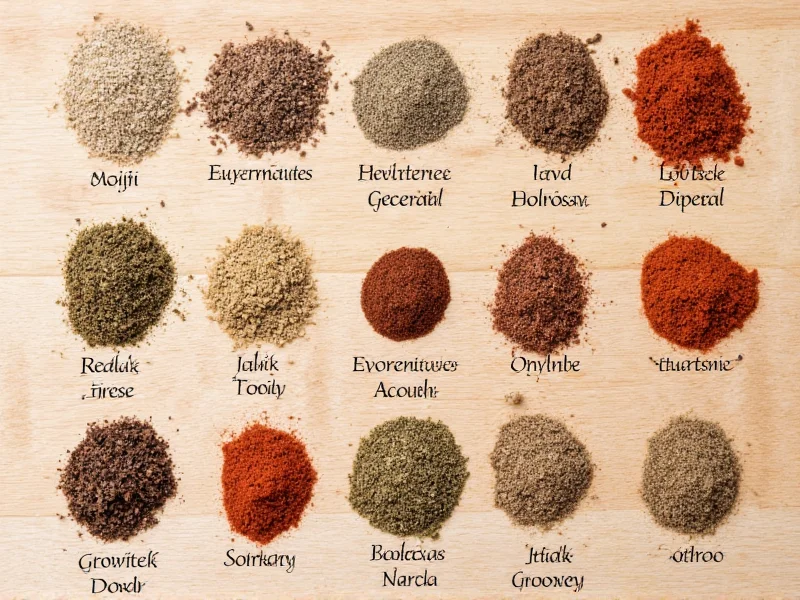Understanding exactly what's in Italian seasoning helps home cooks use this versatile blend effectively. While recipes vary, authentic Italian seasoning combines specific dried herbs in precise proportions to create that distinctive Mediterranean flavor profile that enhances pasta dishes, pizzas, roasted vegetables, and grilled meats.
Core Components of Authentic Italian Seasoning
Despite regional variations, five herbs form the foundation of traditional Italian seasoning blends. These dried herbs work synergistically to create a balanced flavor that's greater than the sum of its parts:
- Oregano - Earthy, slightly bitter, and pungent (typically 25-35% of blend)
- Basil - Sweet, slightly peppery with hints of anise (20-30% of blend)
- Marjoram - Milder cousin of oregano with subtle floral notes (15-20% of blend)
- Thyme - Earthy with lemony undertones (10-15% of blend)
- Rosemary - Pine-like, robust flavor (5-10% of blend)
These proportions create the balanced flavor profile that defines quality Italian seasoning. The oregano and basil provide the dominant flavors, while marjoram adds complexity, and thyme and rosemary contribute distinctive background notes without overwhelming the blend.
Commercial Blend Variations Explained
While the core five-herb combination remains consistent, commercial Italian seasoning blends often include additional ingredients or adjust proportions based on regional preferences and brand formulations. Understanding these variations helps you select the right blend for your culinary needs.
| Brand | Primary Ingredients | Additional Components | Flavor Profile |
|---|---|---|---|
| McCormick | Oregano, Marjoram, Thyme, Rosemary | Garlic powder, Red pepper | Balanced with subtle heat |
| Bertolli | Basil, Oregano, Rosemary | Garlic, Parsley, Citric acid | Bright, herb-forward |
| Simply Organic | Oregano, Thyme, Marjoram, Rosemary, Basil | None (certified organic) | Pure herb flavor |
| Italian Homemade | Basil, Oregano, Rosemary, Thyme, Marjoram | Sage, Fennel seed | Complex, traditional |
Notice how some brands add garlic powder or red pepper flakes for extra dimension. These additions create what many Americans recognize as "Italian seasoning," though traditional Italian cooking typically uses fresh herbs separately rather than pre-mixed blends. The inclusion of garlic powder in many commercial blends reflects American-Italian culinary preferences rather than authentic Italian cooking practices.
Creating Your Own Perfect Italian Seasoning Blend
Making your own Italian seasoning gives you complete control over quality, freshness, and flavor balance. Here's a professional chef-recommended ratio for homemade Italian seasoning that delivers authentic flavor:
Basic Homemade Italian Seasoning Recipe
Yield: Approximately ¼ cup
Prep time: 5 minutes
- 2 tablespoons dried oregano
- 1½ tablespoons dried basil
- 1 tablespoon dried marjoram
- 2 teaspoons dried thyme
- 1½ teaspoons dried rosemary (crushed)
Instructions: Combine all ingredients in a small bowl, mixing thoroughly. Store in an airtight container away from light and heat. Properly stored, homemade Italian seasoning maintains peak flavor for 4-6 months.
For a more complex flavor profile similar to premium commercial blends, consider these customization options:
- Mediterranean style: Add ½ teaspoon dried sage and ¼ teaspoon fennel seeds
- Spicy arrabbiata version: Include ¼-½ teaspoon red pepper flakes
- Chef's secret: Add a pinch of dried lemon zest for brightness
Optimal Culinary Applications and Pairing Guide
Understanding what's in Italian seasoning helps you use it effectively in your cooking. Different dishes benefit from specific applications of this versatile herb blend:
When to Add Italian Seasoning During Cooking
- For sauces and soups: Add early in cooking to allow flavors to meld
- For roasted vegetables: Toss with oil and seasoning before roasting
- For meats: Create a dry rub and apply 30+ minutes before cooking
- For finishing: Sprinkle small amounts of fresh basil on top after cooking
Ideal Food Pairings for Italian Seasoning
- Pasta dishes: Especially tomato-based sauces, where oregano shines
- Pizza: Sprinkle on before baking for authentic flavor
- Roasted vegetables: Eggplant, zucchini, bell peppers, and tomatoes
- Grilled meats: Chicken, pork, and lamb particularly benefit
- Bread: Mix into focaccia or sprinkle on garlic bread
Remember that dried herbs like those in Italian seasoning are more concentrated than fresh herbs. As a general rule, use one-third the amount of dried herbs compared to fresh. For Italian seasoning specifically, start with ¼ teaspoon per serving and adjust to taste.
Common Substitutions and Storage Tips
When you're wondering what's in Italian seasoning and need alternatives, consider these substitution options:
- Herb-specific substitution: Replace with equal parts oregano and basil (the two dominant flavors)
- For immediate use: Combine equal parts fresh oregano, basil, and parsley (use triple the amount of dried)
- When completely out: Herbes de Provence makes a surprisingly good substitute with similar herb profile
Proper storage significantly impacts how long your Italian seasoning maintains its flavor. Store in an airtight container away from heat, light, and moisture. Glass jars with tight-sealing lids work best. Avoid storing above the stove or near windows where temperature fluctuates. Properly stored, commercial Italian seasoning retains good flavor for 1-2 years, while homemade blends are best used within 6 months for peak flavor.











 浙公网安备
33010002000092号
浙公网安备
33010002000092号 浙B2-20120091-4
浙B2-20120091-4